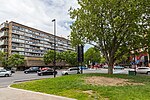South Bank Technopark

South Bank Technopark at London South Bank University, England, houses the main administration for the university, including the Vice-Chancellor's Office, under the leadership of Prof. David Phoenix. The Technopark building was opened in November 1985. Hugh West became its CEO in 1988. It is designed in a modular way, with a floor area of 3,000 m2, which can be divided into units from around 19 m2 in size. As well as university offices, there are also a number of small companies that rent space in the building. The Technopark currently houses 37 high-tech businesses. Technopark is located in London Road just north of the Elephant and Castle on the east side of the road. The Elephant and Castle tube station is very close to the building.
Excerpt from the Wikipedia article South Bank Technopark (License: CC BY-SA 3.0, Authors, Images).South Bank Technopark
Keyworth Street, London Elephant and Castle (London Borough of Southwark)
Geographical coordinates (GPS) Address Nearby Places Show on map
Geographical coordinates (GPS)
| Latitude | Longitude |
|---|---|
| N 51.4968 ° | E -0.1019 ° |
Address
London South Bank University
Keyworth Street
SE1 0AA London, Elephant and Castle (London Borough of Southwark)
England, United Kingdom
Open on Google Maps








